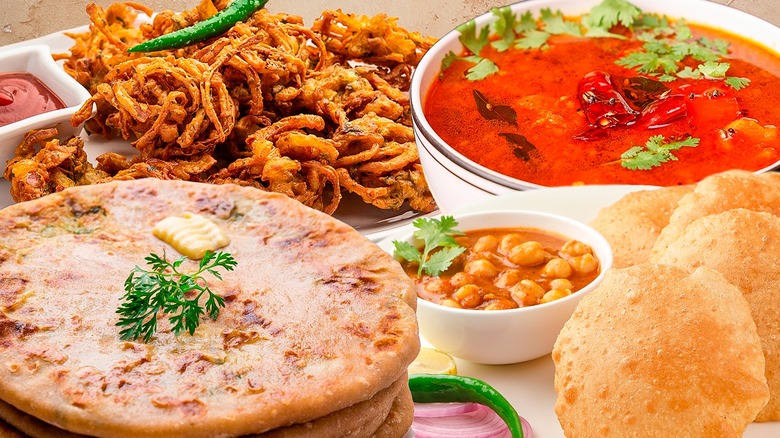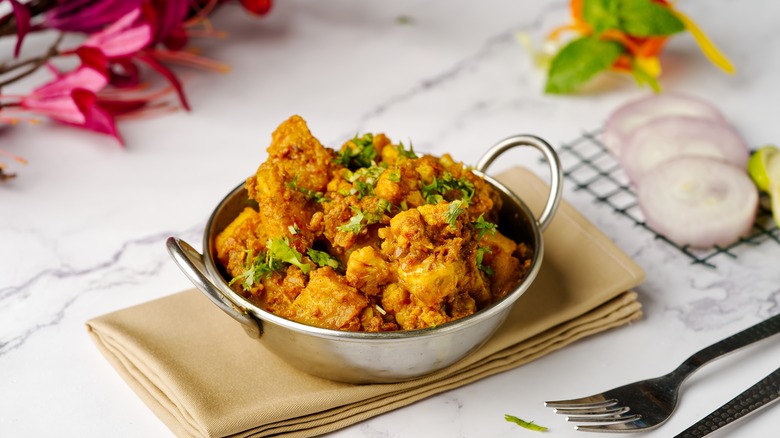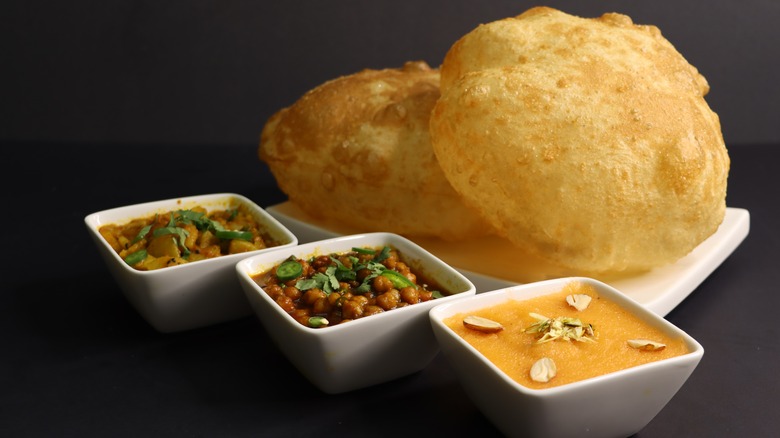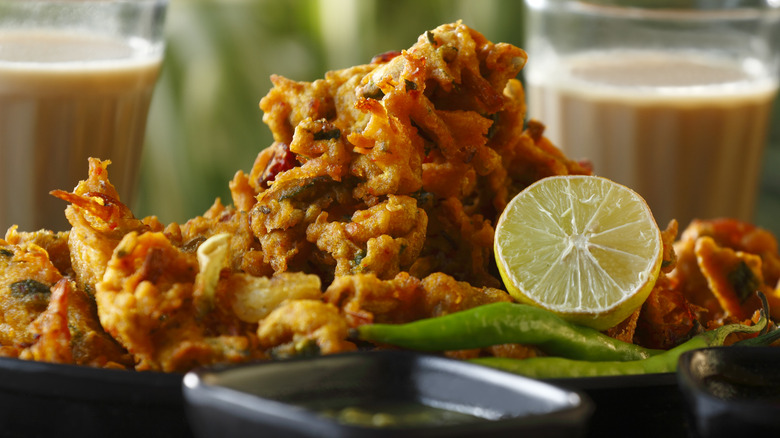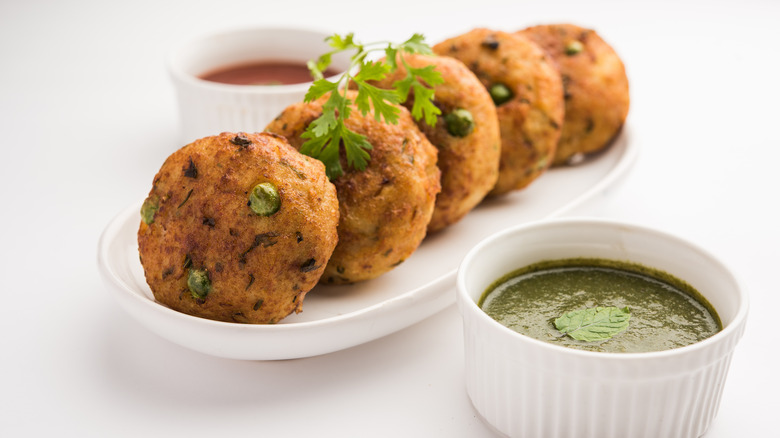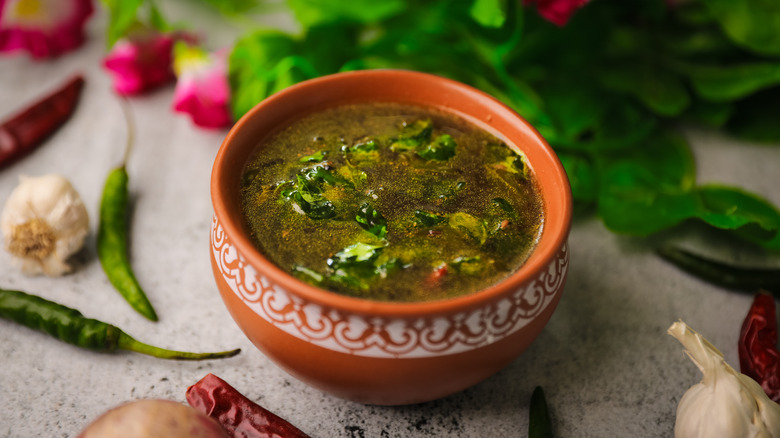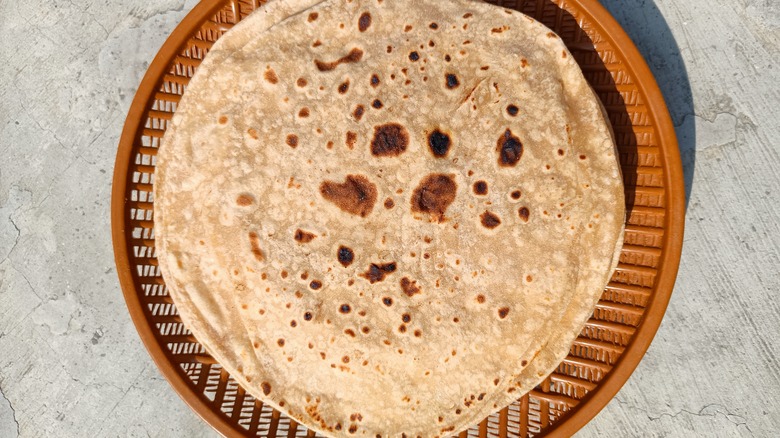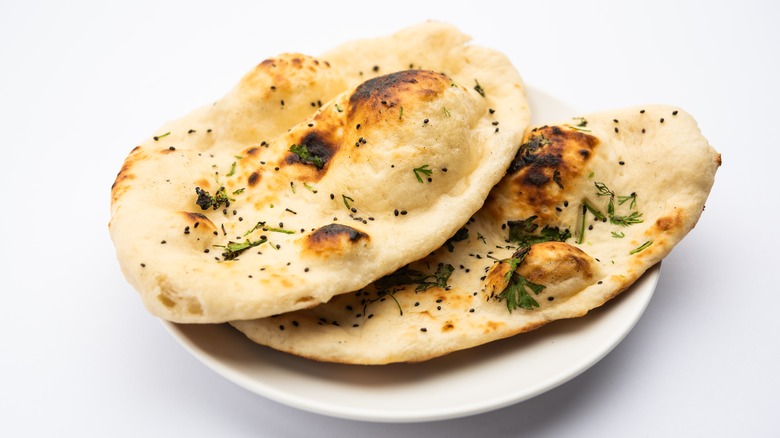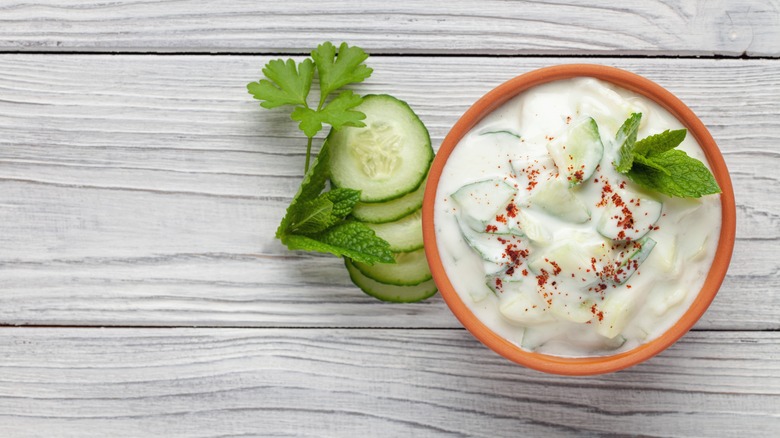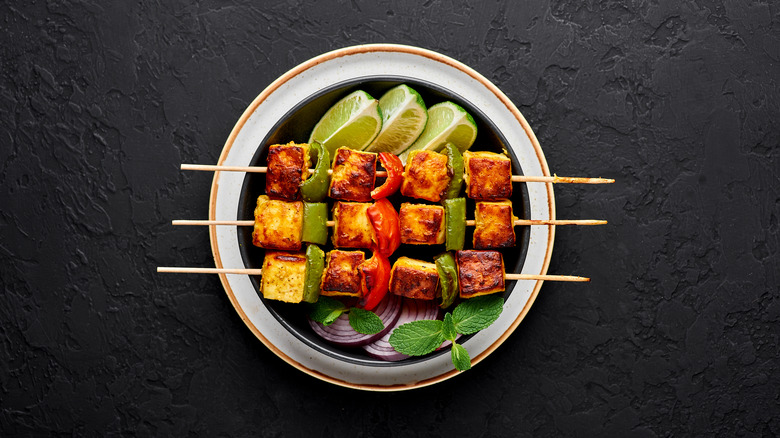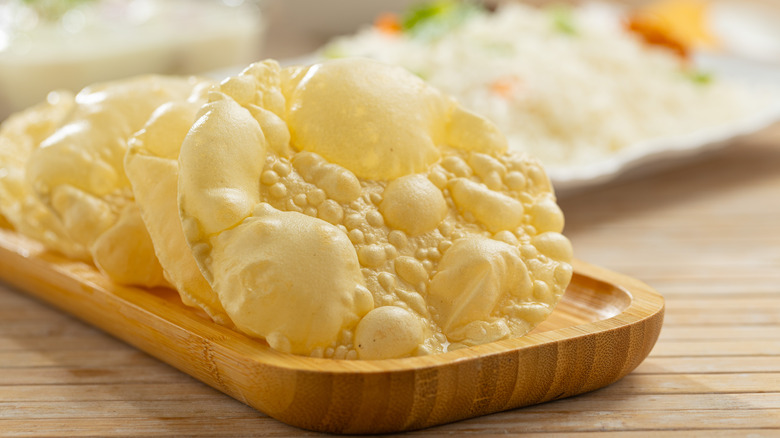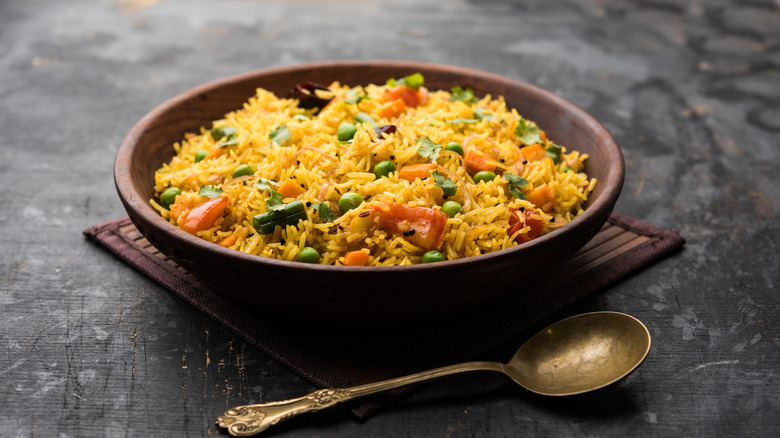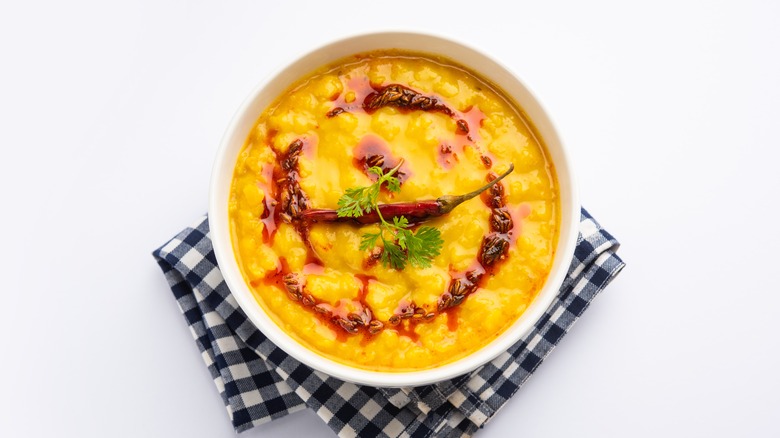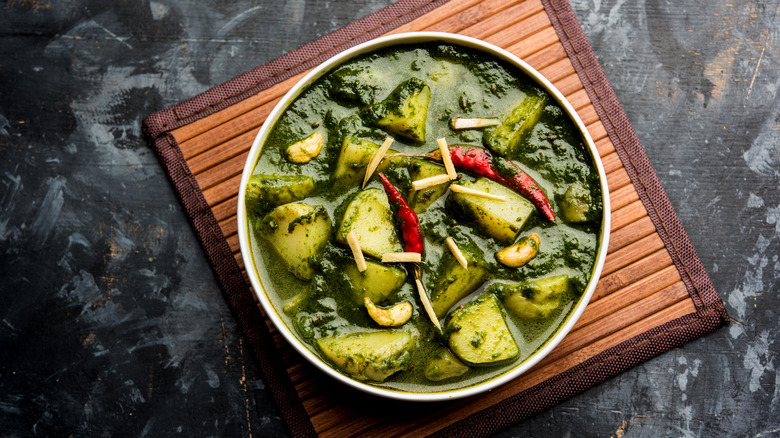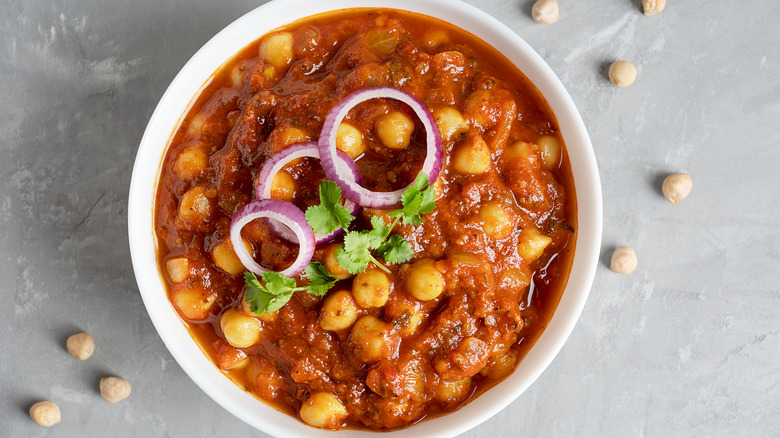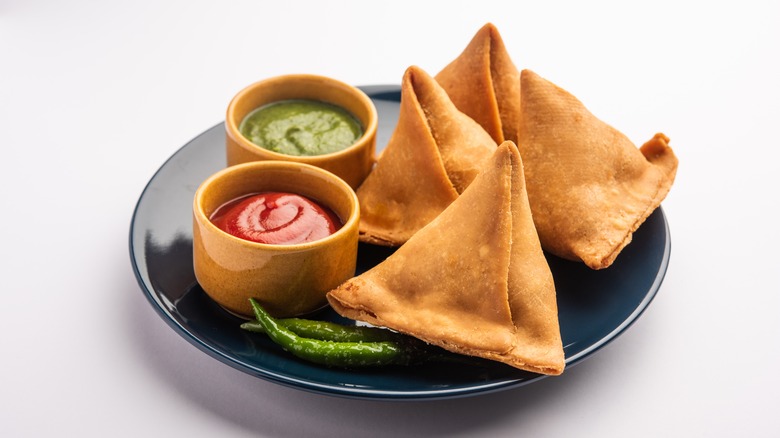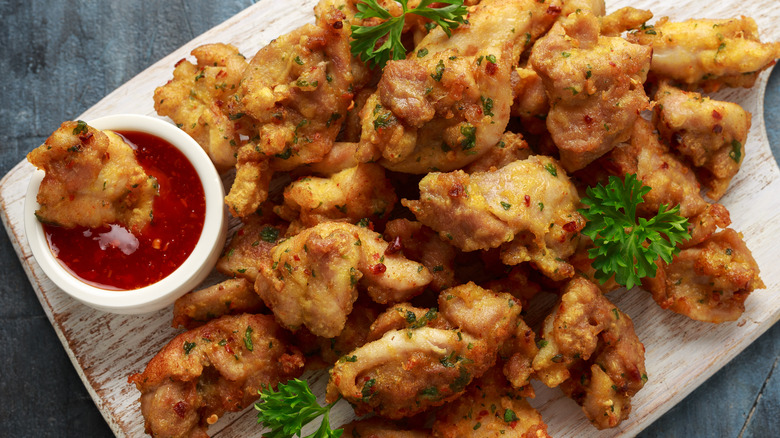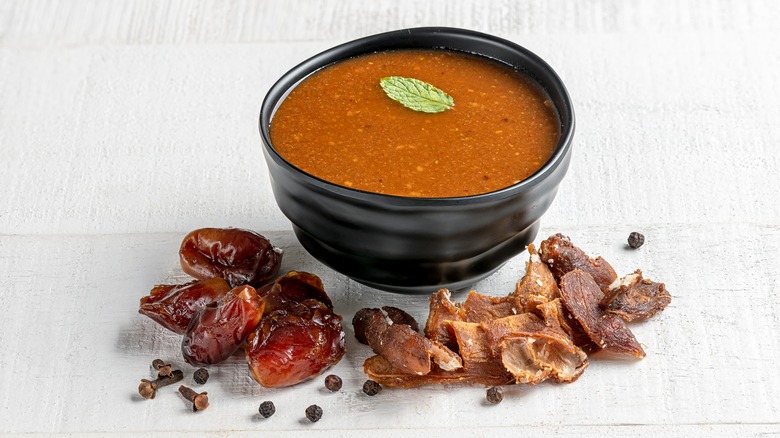17 Indian Side Dishes You Need To Order
Indian food is delicious. The country's national cuisine has a history that spans over five millennia. In that time, a dizzying array of foods and drinks have been developed, influenced by the demographics and commonly-found ingredients of each specific region in the country. Nowadays, Indian food is a global phenomenon, with the cuisine being popular both in the United States and worldwide — thanks to its inimitable combination of spices, flavors, and textures.
If you've ever taken a look at a menu in an Indian restaurant, the full extent of the country's food offerings can be somewhat overwhelming. Travel beyond the main page, and you'll find a world of bread, rice, accompaniments, sundries, and side dishes all waiting to be tried and enjoyed.
We also get that sometimes, with many choices available, it can be tempting to play it safe and stick to your regular order. We're here to put a stop to that. Your Indian meal is practically begging to be joined by a host of awesome side dishes. There are some that you absolutely have to try. Let's take a look at some of our favorites.
1. Aloo gobi
Cauliflower is a pretty big deal in Indian cuisine, but the cruciferous vegetable is a relatively recent addition to the national menu. It was originally brought to India by the British, with the first seeds imported into the country in 1822. The seeds remained and spread. Now, cauliflower can be found across India.
It was in the Indian region of Punjab that aloo gobi first flourished. The dish is a combination of potatoes and cauliflower, which is indicated by its name. "Aloo" means "potato" in Hindi, and "gobi" means "cauliflower." These ingredients are cooked together with an array of spices to make a dry curry.
The cauliflower and potatoes are chopped into smaller pieces, then fried with onion and garlic, before spices like cumin and mustard seeds, turmeric, fenugreek, and garam masala are tossed in. The whole thing is then left to cook until the vegetables are tender and the spices fragrant. While aloo gobi is hearty enough to be enjoyed as a main, thanks to the chunky vegetables involved, it's also excellent served as a side dish. Aloo gobi goes especially well with dal or a meat-based curry. And the best part? If you have any leftovers to take home with you, it's even better the next day.
2. Puri
Like most other countries in the world, bread is an Indian staple food. The range of different types of bread available is pretty stunning. The next time that you're in an Indian restaurant, we encourage you to go beyond your regular naan or chapati and try puri instead.
Puri, or poori, is deep-fried bread made with wheat flour. To make puri, chefs take pieces of a simple dough, and press or roll them into a small disc. The disc is then placed carefully in a pot of hot oil, where it puffs up, creating a piece of crisp bread with a large air pocket in the middle.
This bread can be ordered to accompany pretty much any dish, and it's particularly good as a vehicle for drier curries. It's also a common part of traditional celebratory breakfasts. Puri also serves the basis of a much-loved street snack in India, called pani puri. Small globes of puri are made, with the top of each piece of puri cut off to create an opening. The puri is then filled with a range of delicious things like tamarind chutney, mashed potato, and onion. It's then enjoyed by people on the go.
3. Onion bhaji
You haven't truly lived until you've tried onion bhajis. Perhaps the ultimate Indian side dish, onion bhajis are essentially onion fritters, created with pieces of sliced onion held together in a batter made from chickpea or gram flour. Onion bhajis were originally conceived in southwestern Karnataka, and are usually eaten as a snack, appetizer, or street food. Alongside a curry, however, they provide an incredible flavor and texture contrast.
Onion bhajis are just one of many bhajis, with the word being used to refer to any fried vegetable fritter. To make onion bhajis, cooks will slice onions into long rings or pieces, thin enough to remain malleable. Then, they're added to the batter, which is often flavored with spices like cumin, turmeric, and coriander. The onion and batter mixture is then shaped into balls, discs, or other shapes, and then fried in oil, until the outside of the bhaji is crispy and the inside remains soft. They're then taken out, given a moment or two for the excess oil to drain off, and then plated up. Onion bhajis are best served alongside something moist and are best when they come with something to dip them in, like a mango chutney or raita.
4. Aloo tikki
One thing that India absolutely nails are its snack foods. One type of snack food, known as chaat, is particularly popular throughout the country and across the globe. Chaat is a name that refers to several savory dishes made by frying dough — usually topped with fresh ingredients and served hot — alongside chutney. Over time, chaat has transformed from being street food to being available as side dishes or starters in Indian restaurants. One of the most popular, aloo tikki, is a firm fixture on menus.
Aloo tikki is a fried potato patty, usually stuffed with lentils or peas and served hot. Potatoes are boiled until soft, mashed, and formed into discs around the stuffing of choice. They're then fried in hot oil or ghee until crisp. Aloo tikki can be enjoyed on its own, or it can make a bomb side dish. It shines especially bright next to dals and curries, with the moistness of these meals stopping the aloo tikki from feeling too dense. What's non-negotiable, too, is enjoying aloo tikki with chutney.
5. Rasam
Rasam had a moment in the U.S. during the COVID-19 pandemic, with the dish suddenly seeing a surge in popularity in 2020 thanks to its purported health benefits, per The Better India. But this stew has been around for way longer than that. Rasam has a centuries-old history, first becoming popular in South India, and is a predecessor to mulligatawny soup. It generally appears as a soup or thin stew, with a clear or slightly-colored broth, into which a range of vegetables, pulses, and even meat is added.
Though rasam might look simple, its intricate flavor combinations will blow you away. The soup is tangy and tart, thanks to the broth being made from tamarind or sometimes kokum, a sour fruit that grows in southwest India. The broth is also frequently spiced with other flavors like coriander and turmeric. Add in a plethora of vegetables like carrots, chickpeas, and greens, and it's no wonder that this soup became so prized for its potential restorative properties.
Rasam makes a great choice as an accompaniment if you're trying to stay away from the slightly more dense end of the side dish spectrum like onion bhajis and aloo tikki. Try ordering it alongside tandoori dishes, dry curries, or rice-based dishes. Some bowls of rasam may also be filling enough to have as a main course, with a serving of rice.
6. Roti
In Indian cuisine, a few styles of bread compete for dominance, each one as delicious as the last. Roti puts in a strong claim to being the ultimate champion. Roti is a widely available unleavened flatbread, not only in India but across large swathes of the Indian subcontinent and other countries beyond, including Malaysia and Singapore. Its history, though, is likely to start in southern India, and it's a regular component of people's diets both there and in the country at large.
In India, roti (or chapati) is made using a simple recipe of wholemeal flour, water, and a pinch of salt for flavor. Each piece of dough is rolled and stretched until it's super-flat. It's then cooked until both sides are blistered and browned, then served pretty much instantly — sometimes brushed with a bit of fat to make it even tastier.
Roti is a must-have side dish for countless people. Its simplicity means it goes well with pretty much anything. It's commonly served alongside curries, where it's used as a vehicle for the sauce to make its way directly to your mouth. Roti can also be enjoyed more simply, with a yogurt sauce or chutney.
7. Naan
Look, we all have our go-to order in an Indian restaurant. But if that order doesn't include naan bread, you're missing out. Naan is a quintessential Indian bread. Like roti, it is eaten across the country. Whereas roti is always unleavened, naan can be either leavened or unleavened and is made using wheat flour.
What sets naan bread apart is its cooking method. To make this bread, pieces of dough are placed in a tandoor, a traditional clay oven that looks like a big pot or an urn. In the tandoor, the bread not only cooks through but develops a smoky, slightly crisp exterior, giving the naan a unique flavor and visual style. They can be made smaller so that they're well-suited to individual portions, or come as large sheets of bread, which are best torn apart and shared with friends.
Similar to roti, plain naan bread can go with pretty much anything, and is perhaps best enjoyed alongside curry. Naan bread can also frequently be flavored with additional ingredients, with garlic and coriander commonly used. This type of bread can also be served stuffed, for an extra-luxurious touch, with nuts and even meat tucked into a naan before cooking.
8. Raita
In our opinion, few Indian meals are complete without raita featured somewhere. This ever-present condiment can be found accompanying an enormous amount of dishes in Indian cuisine. Raita is a yogurt-based sauce, into which a variety of vegetables are stirred. The dish is then served cold. As well as being tasty, raita also has a functional purpose: The use of yogurt and its serving temperature help to temper any fierce spices in the dish it's being served with, as well as generally cool the body down in warmer climates.
For most people, raita is most commonly found with cucumber in it. Finely-chopped or grated cucumber is stirred into the yogurt, with onion, garlic, or other herbs and spices added. But it's important to remember that raita can contain virtually any fruit or vegetable. Tomato is often found in the condiment, and slightly more left-field choices like pomegranate, pumpkin, guava, eggplant, and radish may all make appearances in the sauce, too. Raita goes with pretty much anything. Whatever you're getting, you won't regret having a pot of raita to hand, so go ahead and add it to your order.
9. Paneer tikka
With roughly 1,800 types of cheese across the globe, it's little surprise that it shows up pretty much everywhere, including in Indian cuisine. And in Indian cooking, paneer is the cheese of choice. Paneer is a firm cheese that holds its shape when cooked, similar to halloumi. It's made with cow's milk and lemon juice and is frequently used in place of meat in dishes like curries.
But it's also a staple in Indian side dishes, from saag paneer to paneer tikka — and it's the latter that you need to try ordering. Paneer tikka is northern Indian in origin and is made by marinating chunks of paneer in a mixture of yogurt and spices, with the word "tikka" referring to its marination process. Once they've had a chance to imbue with flavor, these chunks are then threaded onto skewers, with chunks of vegetables like onions or peppers placed between each piece of cheese. The finished skewers are then cooked in a tandoor oven, which gives them unparalleled char and smokiness.
Paneer tikka can be served as a side dish with any main you desire and will give your whole meal a boost of protein. Alternatively, you can enjoy paneer tikka as a main. Order it with naan bread and some condiments, and wrap it all up to make a paneer sandwich (making sure, of course, to remove the skewer before chomping into it).
10. Poppadoms
It is our firm belief that most meals benefit from a little bit of crunch. But you can't exactly crack open a pack of potato chips in the middle of the Indian restaurant you're eating in. Luckily, though, you don't have to, if they have poppadoms on the menu. In India, poppadoms are eaten either as an appetizer or snack or as a component of the main meal, depending on what part of the country you're in. Poppadoms are commonly made from black gram bean flour, although alternative flours, like those made from lentils or chickpeas, can also be used.
When cooked (which can be done via a range of methods, like frying, deep-frying, roasting, or even microwaving), poppadoms end up as crispy, flat discs, which can be broken into pieces and slathered in chutney or raita. Fiercely-spiced pickles and chopped vegetables are also often used as toppings, and they can sometimes be used as ingredients in other dishes. In our opinion, poppadoms make the perfect starter or appetizer at the beginning of an Indian meal, as they're light and crispy enough to whet the appetite without filling you up. You might also wish to order them alongside your main meal, to provide a textural contrast.
11. Pilau rice
No curry is complete without rice. In Indian restaurants, you might be familiar with ordering a side of plain basmati, which delivers a lightly fragrant bed of carbs for your spicy sauce, meat, and vegetables to lay upon. Next time you're eating out, though, try ordering pilau rice instead.
Pilau rice is basmati taken to the next level. While each recipe will vary slightly, it's typically a gently-spiced rice dish, flavored with additions like saffron, turmeric, cinnamon, and cardamom. Pilau may also contain added vegetables, like peas and carrots, as well as slivered almonds or other nuts, and occasionally a sweet element like raisins.
There are many dishes similar to pilau found in different cuisines, outside of Indian food. You're just as likely to find pilau rice in a restaurant serving Afghan, Iranian, Turkish, Pakistani, Bangladeshi, or Caribbean cuisine. Because of the reach and ubiquity of this dish, its origins are hotly contested. Some people claim that the dish is Indian in origin, but others state that it was first made in Iran or in the surrounding regions. Wherever it's from, though, it's an essential Indian side dish. Regular pilau rice can make for a far more exciting side dish than regular basmati, and in some cases, it can be a main meal on its own.
12. Tadka dal
Lentils are a huge component of Indian cuisine, offering a vital source of protein for the country's huge vegetarian population. From being ground into flour to make bread and crispy snacks, to being used whole, these little legumes are everywhere.
Tadka dal is arguably one of the most delicious ways to enjoy lentils. The dish is a lentil curry that is made by cooking lentils with spices added in water until they're tender. The chef then adds in a separately-cooked mixture of spices, ginger, chili, and garlic, to make it even more tasty.
This dish, in various forms, has been served for thousands of years. It is traditionally associated with celebrations. As such, it's a distinctly special-feeling dish, despite being made using readily-available ingredients. Tadka dal is a great side dish to order if you're dining with friends or family, and we'd recommend including it while trying out a range of different curries, so everyone gets to sample a little bit of each thing. For vegetarians, though, this curry is also filling enough to have as a main, alongside some rice, roti, or naan bread.
13. Saag aloo
If there's one thing Indian cuisine knows how to do, it's to take fairly neutral-tasting ingredients and turn them into something utterly delicious. That kind of ethos is potentially what led to the development of saag aloo. This dish is a concoction of spinach and potatoes, simmered together with spices and flavorings to make a delicious vegetarian curry. Spices in the dish may include turmeric, cumin, coriander, and garam masala.
The word "saag" actually refers to the most basic form of this dish, which is a leaf-based curry made from spinach or other greens. "Aloo" means potato, which refers to its inclusion in the dish. There are other variations of saag out there, including saag paneer. This dish uses paneer cheese instead of potato. Other types of saag have chickpeas, other pulses, and even meat. In our opinion, though, saag aloo is one of the best versions of this dish to order as a side, as it's simple enough to complement your main dish while also spicing things up a little. Just make sure you share it with your buddies.
14. Chole
The chickpea is a pretty incredible thing, huh? These legumes form a core part of so many countries' staple foods. It's no surprise, due to them being high in protein, fiber, vitamins, and minerals. They are also cheap and plentiful. Indian cuisine is no exception and chickpeas are part of countless recipes. Chole is one of the most well-known and well-loved chickpea dishes out there.
Chole is a chickpea curry that can be found in various forms across India, most notably in the Punjab region. It's also often called chole masala, with masala referring to the spices used in it. The curry will usually be spiced with red chili powder, cumin, coriander, and turmeric, amongst other additions, and the size and type of chickpeas can vary. Different restaurants can also mix up how dry their chole is: Some places will serve a chole that has a runnier gravy, whereas, in others, there may not be that much sauce at all.
This dish is also a popular street food in India, where it can be served with a garnish of coriander and chilies, and with bread, sliced onions, and pickles. This can make a hearty enough main on its own. But split between a few people, it's an awesome side.
15. Samosa
Indian cuisine is very, very good at snacks, appetizers, and side dishes. The best of these foods are as delicious as a quick bite as they are next to a main meal. There's a strong argument to be made that the unassuming samosa is the best food for all of these occasions. Samosas were originally created in Central Asia before the migration of communities populating these areas to India caused the food to travel with it. Once there, samosas took the country by storm. They are popular both as street food and as something that can be enjoyed in a slower, more relaxed dining setting.
Samosas are fried pastries filled with a variety of spicy fillings. Indian samosas can vary in size, from pretty small to the size of a plate, but they're usually triangular or slightly conical in shape. Inside the samosa can be a range of spiced vegetables, pulses, legumes, and meat — with boiled or mashed potatoes and peas often appearing. What's inside a samosa and the shape of it, though, are only limited by the chef's creativity. Samosas go well with pretty much anything on the menu, but if you want to enjoy them to their fullest potential, try ordering them as a starter before the main event.
16. Pakora
Most food cultures around the world have some form of fritter, and Indian food is no different. In fact, it's arguable that Indian cuisine has one of the widest ranges of fritters available, and many of them are sold as pakora. Pakora can refer to pretty much any item of food that's been coated in a chickpea flour batter, then dipped in hot oil and fried until golden. These batters are often well-spiced to give the pakora additional flavor.
Onion bhajis are arguably one of the most famous forms of pakora, but the truth is that there's a dizzying range of pakora out there, and virtually any vegetable can be coated and fried. Potatoes, eggplants, peppers, cauliflower, paneer, and chicken are all regularly made into pakora. These ingredients are usually formed into patties or balls, with the batter keeping them all together, and the frying process serving to bind them fully. This makes them the ideal snack for eating on the run, but in an Indian restaurant, they make the ideal crunchy side dish for curries, dals, or biryanis.
17. Chutney
Meals are at their best when they get the balance of different flavors just right. One of the best ways to give a meal some sweetness and tanginess — that would be hard to find elsewhere — is by ordering a side of chutney.
Chutney is a condiment that's sweet, savory, and spicy all at the same time. Coming from the Hindi word "chatni," which means "to crush," chutneys come in all different styles in India. The condiment is served with an extraordinarily large range of foods, either to dip snack foods in or poured over the top of things.
The name "chutney" refers to how it's traditionally made, by mashing together whatever produce is being used to make the chutney in a mortar and pestle until it becomes a thick paste or liquid. These days, commercially-produced chutneys can be noticeably sweeter and potentially less spicy, but there are some pretty fierce chutneys out there. Mango, tomato, cucumber, and lime are all often used to make this condiment. The truth, though, is that virtually any fruit or vegetable can be tossed in a chutney, and in some parts of India, ingredients like dried fish might be used as a core part of recipes. In an Indian restaurant, chutney is frequently served with poppadoms, samosas, and pakora, but it goes well with almost anything on your table.
